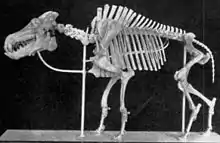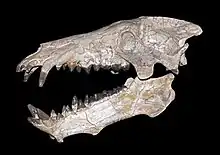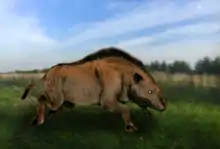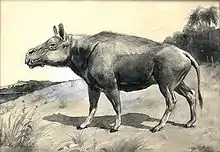Entelodont
Entelodonts—sometimes nicknamed hell pigs or terminator pigs[3]—are an extinct family of pig-like omnivores of the forests and plains of North America, although they were more common in western regions than the east,[4] and Eurasia from the late Eocene[1][5] to middle Miocene epochs (37.2–15.97 million years ago), existing for about 21.23 million years.[6]
| Entelodonts | |
|---|---|
 | |
| Daeodon skeleton | |
| Scientific classification | |
| Kingdom: | Animalia |
| Phylum: | Chordata |
| Class: | Mammalia |
| Order: | Artiodactyla |
| Clade: | Cetancodontamorpha [2] |
| Family: | †Entelodontidae Lydekker, 1883 |
| Genera | |
| Synonyms | |
| |
| Look up entelodont in Wiktionary, the free dictionary. |
Taxonomy

The Entelodontidae were named by Richard Lydekker and assigned to Nonruminantia by Gregory (1910).[7] They were then assigned to Artiodactyla by Lucas et al.[8] (1998) and to Entelodontoidea by Carroll (1988) and Boisserie et al. (2005). While entelodonts have long been classified as members of the Suina, Spaulding et al. have found them to be closer to whales and hippos than to pigs.[9] Cladistic analysis of the position of whales in relation to artiodactyls and mesonychians changes radically depending on whether the giant enigmatic mammal Andrewsarchus is included, and it has been suggested that Andrewsarchus is in fact an entelodont or close relative.[10]
Description
Entelodonts are an extinct group of rather pig-like omnivorous mammals with bulky bodies, slender legs, and long muzzles. The largest entelodont known by the complete skeleton was the North American Daeodon shoshonensis standing up to 2.1 m (6.9 ft) tall at the shoulder. Eurasian Paraentelodon intermedium, known mostly by the teeth and jaws, was similar in size to the Daeodon.[11][12]
Entelodonts had full sets of teeth, including large canines, heavy incisors, pointed premolars, and relatively simple flat molars. These features suggest an omnivorous diet similar to that of modern pigs. In larger species, a bison-like spinal hump supported the weight of the heavy head. The length and proportions of their leg bones are consistent with other hoofed animals that run well on open ground but are not built for high speed. Like many artiodactyls, they had cloven hooves, with two toes touching the ground, and the remaining two being vestigial.[13]
Enteledonts had huge heads, with bony expansions of the cheekbones and bony bosses on the jaws. Some of these may have been attachment points for powerful jaw muscles,[13][14] but in some species the growths were larger in some adult specimens than others. Based on the common pattern in artiodactyls, the individuals with the larger ornaments are assumed to be males, and these features may have protected the eyes and throat in combat between males that involved biting or jaw-wrestling. Enteledonts could open their mouths unusually wide.[15] This anatomy has been related to hunting or carrion-feeding, but modern hippos, a related group with the same adaptation, are aggressive herbivores that open their jaws up to 150 degrees and display enlarged canines in order to intimidate rivals. Males engage in head-to-head "yawning" and jaw-wrestling contests, while females attack by approaching from the side and slamming their head into the opponent's body.[16] Both facial and ribcage injuries have been attributed to intraspecies aggression in Archaeotherium.[17]
Paleobiology
Entelodonts resembled a cow and a rhino and are known to have lived from the middle Eocene until the early Miocene in China, Europe, and North America. Other animals in their environments filled apex predator niches, including cat-like nimravid sabertooths, amphicyonids (bear-dogs), and hyaenodontid creodonts. The extent to which entelodonts were predators is debated, however, wear patterns on entelodont teeth do resemble modern carnivorans in some respects. There is also evidence of entelodonts caching the bodies of early camelids as a food source,[18] as well as multiple examples of toothmarks on bones. Entelodonts were among the largest animals in their environments and could easily exploit any available food. Analysis of their dentition shows both very high jaw strength and extreme tooth wear. Their front teeth interlocked, so they could not have cropped grass. The oddly expanded semi-circular forepart of the skull, specific to this group and Andrewsarchus and similar to hippos, suggests adaptations for tooth display or grasping. Wear grooves on the front teeth suggest stripping leaves or bark. The intense wear on incisors, canines, and the heavy cone-shaped premolars, which often wore down to the roots, makes clear they ate tough or sandy foods, but the lack of grinding teeth means they did not specialize on grass or fibrous plants. Characteristic "pie crust" fracture wear on the triangular premolars of Archeotherium is also seen in modern hyenas, and suggests some specialization for bone-eating. Like humans, pigs, and most bears, entelodonts also had flat crushing molars to process a variety of foods. They may have lived both by scavenging carcasses and eating as modern pigs and peccaries do, taking in fruit, nuts, roots, bark, leaves, fungi, invertebrates, and the occasional smaller vertebrate animal.[19]
Daeodon, one of the largest species, has been recovered from the Miocene Agate Springs bonebed (Nebraska, 19–21 mya), where it lived in a floodplain environment with wet and dry seasons. It shared this landscape with small gazelle-like camels, the large browsing chalicothere Moropus, several species of predatory coyote- to wolf-sized amphicyonids that lived in packs, land beavers (Palaeocastor) that filled the ecological niche of modern prairie dogs, and thousands of small herd-living rhinoceros. The rhinos suffered massive periodic die-offs in the dry season, but Daeodon fossils are rare, which suggests they were neither social animals nor especially attracted to carrion.[20]
In popular culture
Entelodonts appear in the third episode of the popular BBC documentary Walking with Beasts, where, in the program, the narrator always refers to the creatures as "entelodonts" rather than a more specific genus, such as Entelodon or Paraentelodon. The same creatures appear in another BBC production, the 2001 remake of The Lost World.
Entelodonts were also the main focus of episode 4 of National Geographic Channel's show Prehistoric Predators in an episode titled "Killer Pig". The episode featured a number of claims unproven or disproven by science, such as Archaeotherium (identified as "entelodont") being the top predator of the American Badlands, and evolving directly into the even larger Daeodon (called "Dinohyus" in the episode).
References
- I. A. Vislobokova. "The oldest representative of Entelodontoidea (Artiodactyla, Suiformes) from the Middle Eocene of Khaichin Ula II, Mongolia, and some evolutionary features of this superfamily" Paleontological Institute, Russian Academy of Sciences, Profsoyuznaya ul. 123, Moscow, 117997, Russia
- Spaulding, Michelle; O'Leary, Maureen A.; Gatesy, John (2009). Farke, Andrew Allen (ed.). "Relationships of Cetacea (Artiodactyla) Among Mammals: Increased Taxon Sampling Alters Interpretations of Key Fossils and Character Evolution". PLOS ONE. 4 (9): e7062. Bibcode:2009PLoSO...4.7062S. doi:10.1371/journal.pone.0007062. PMC 2740860. PMID 19774069.
- Adrienne Mayor Fossil Legends of the First Americans. Princeton University Press, 2005. p. 213
- Price, Mark (30 March 2020). "Rock found in Mississippi proves to be fossilized tooth from prehistoric 'hell pig'". The Charlotte Observer. The Charlotte Observer. Retrieved 27 January 2021.
- Vislobokova, I. A. (12 November 2008). "The oldest representative of Entelodontoidea (Artiodactyla, Suiformes) from the Middle Eocene of Khaichin Ula II, Mongolia, and some evolutionary features of this superfamily". Paleontological Journal. 42 (6): 643–654. doi:10.1134/S0031030108060105. S2CID 83856459.
- PaleoBiology Database: Entelodonts, basic info
- W. K. Gregory. 1910. The orders of mammals. Bulletin of the American Museum of Natural History 27:1-524
- S. G. Lucas, R. J. Emry, and S. E. Foss. 1998. Taxonomy and distribution of Daeodon, an Oligocene-Miocene entelodont (Mammalia: Artiodactyla) from North America. Proceedings of the Biological Society of Washington 111(2):425-435
- Spaulding, Michelle; O'Leary, Maureen A.; Gatesy, John (2009). "Relationships of Cetacea (Artiodactyla) among mammals: increased taxon sampling alters interpretations of key fossils and character evolution". PLOS ONE. 4 (9): e7062. Bibcode:2009PLoSO...4.7062S. doi:10.1371/journal.pone.0007062. PMC 2740860. PMID 19774069.
- "Mesonychians part II: Andrewsarchus was a hell of a lot weirder than all the books say". Tetrapod Zoology. Retrieved 2018-10-28.
- L. K. Gabunia (1964). Бернарская фауна олигоценовых позвоночных (The Benarskaya Fauna of Oligocene Vertebrates). Metsniereba, Tbilisi. p. 109-133. Retrieved 2020-09-26.
- Donald R. Prothero, Scott E. Foss (2007). The Evolution of Artiodactyls. The Johns Hopkins University Press. p. 128-129. ISBN 9780801887352. Retrieved 2020-09-26.
- Savage, RJG & Long, MR (1986). Mammal Evolution: an illustrated guide. New York: Facts on File. pp. 209–210. ISBN 978-0-8160-1194-0.
- Palmer, D., ed. (1999). The Marshall Illustrated Encyclopedia of Dinosaurs and Prehistoric Animals. London: Marshall Editions. p. 267. ISBN 978-1-84028-152-1.
- "Palaeos Vertebrates Cetartiodactyla: Artiodactyla: Derived Suina". palaeos.com. Retrieved 2018-10-28.
- "Hippopotamus Fact Sheet". library.sandiegozoo.org. Archived from the original on 2018-07-20. Retrieved 2018-10-28.
- Tanke, Darren H. and Phillip J. Currie (1996). "HEAD-BITING BEHAVIOR IN THEROPOD DINOSAURS: PALEOPATHOLOGICAL EVIDENCE" (PDF). GAIA N°15. LlSBOAlLISBON. DEZEMBRO/DECEMBER 1998. pp. 167-184 (ISSN: 0871-5424). Retrieved October 28, 2018.
- http://www.douglasfossils.com/multi_kill.html
- Joeckel, R. M. (1990). "A Functional Interpretation of the Masticatory System and Paleoecology of Entelodonts". Paleobiology. 16 (4): 459–482. doi:10.1017/S0094837300010198. JSTOR 2400970.
- "Mammal Fossils - Agate Fossil Beds National Monument (U.S. National Park Service)". www.nps.gov. Retrieved 2018-10-28.
External links
- "Museum display of Entelodont skeleton :: Geoscience Slides". University of Iowa. Entelodont Skeleton.

